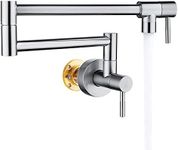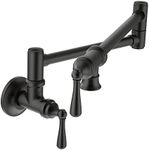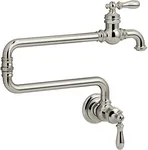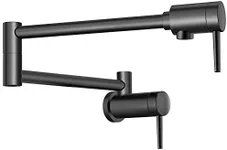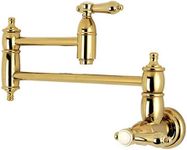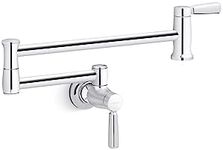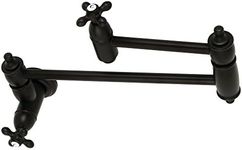Buying Guide for the Best Pot Filler Faucets
Choosing a pot-filler faucet can make your kitchen more convenient, especially if you often cook large meals or use big pots. A pot-filler is a special faucet installed near your stove, allowing you to fill pots with water right where you cook, saving you from carrying heavy, water-filled pots from the sink. When picking the right pot-filler faucet, it's important to consider a few key features to ensure it fits your kitchen setup and meets your needs.Reach/Spout LengthReach or spout length refers to how far the faucet can extend from its mounting point. This is important because it determines whether the faucet can comfortably reach all your burners or the area where you usually place your pots. Shorter reaches (around 15-18 inches) are suitable for smaller stoves or if you only need to fill pots in one spot, while longer reaches (20 inches or more) are better for larger cooktops or if you want more flexibility. To pick the right reach, measure the distance from your wall to the farthest burner and choose a faucet that can easily reach that spot.
Number of Joints/ArticulationThe number of joints or articulations refers to how many pivot points the faucet has, which affects how flexible and easy it is to position. Faucets with one joint can swing out but have limited movement, while those with two or more joints can fold and extend in more directions, making them easier to tuck away or reach different burners. If you want maximum flexibility and the ability to fold the faucet out of the way when not in use, look for a model with two joints. If your needs are simple, a single-joint faucet may be enough.
Mounting TypePot-filler faucets are usually wall-mounted, but some can be deck-mounted (installed on the countertop). Wall-mounted options are most common and save counter space, but require plumbing in the wall behind your stove. Deck-mounted models are easier to install if you have the right countertop setup. Your choice depends on your kitchen's layout and whether you can access plumbing behind your stove. If you’re remodeling or building a new kitchen, wall-mounting is often preferred for its clean look and convenience.
Flow RateFlow rate is the amount of water the faucet delivers, usually measured in gallons per minute (GPM). A higher flow rate (2.0 GPM or more) fills pots faster, which is helpful if you often use large pots. Lower flow rates (1.5 GPM or less) are more water-efficient but may take longer to fill big containers. Consider how often you need to fill large pots and how important speed is to you when choosing the flow rate.
Valve TypeThe valve type controls how you turn the water on and off. Most pot-fillers have one or two valves (handles). Two-valve designs let you control water at both the wall and the spout, which adds safety by reducing the risk of leaks. Single-valve models are simpler but may be less secure. If you want extra peace of mind, especially if you have kids or want to prevent drips, a two-valve faucet is a good choice.
Material and FinishMaterial and finish affect both the durability and appearance of your pot-filler. Common materials include brass, stainless steel, and sometimes zinc. Brass and stainless steel are more durable and resistant to corrosion, making them better for long-term use. The finish (like chrome, brushed nickel, or matte black) should match your kitchen style and be easy to clean. If you want a faucet that lasts and looks good, choose a sturdy material and a finish that fits your kitchen decor.



